Royal Armada of Spain in 1808 year
Real armada Española
It is generally accepted that after the defeat of the Spanish Armada, Spain proper ceased to be a serious force at sea. This, to put it mildly, is not so - without strong naval forces, Spain would not have been able to maintain contact with the colonies and protect them, and she did this for more than two hundred years after the defeat of the Armada. It would be appropriate to say that Spain has ceased to be a uniquely dominant force at sea, but the power of its fleet was more than enough to remain among the leading maritime powers of Europe. However, like any other fleet, the Armada experienced an ups and downs at different times. The next rise of the fleet was outlined at the beginning of the 18th century.
With the coming to power in Spain of the Bourbons, under Philip V, the active fleet Bernardo Tinahera became Secretary of the fleet, and the famous Spanish engineer José Antonio Gastanieta was operating in the shipyards for several years. For shipbuilding Spain at that time was characterized by a large number of small shipyards [1] and complete chaos in terms of the organization of the construction, which made the construction more expensive and complicated it considerably. The gastanetus, with the support of the King and the Registrar of the Navy, published his work Proporciones más esenciales para la fábrica de navíos y fragatas in 1720, recommending how the construction of a modern navy should be organized - how to store wood, how to use it, what design features of ships contribute to their speed or structural strength, etc. This led to the emergence in the Spanish shipbuilding of the so-called “Gastanieta System”, which determined the development of the fleet in the first half of the 18th century. Although Gastanieta soon died, ships were already being built according to his system. The largest brainchild of his theory was the “Royal Felipe”, armed with 114 guns. However, it was impossible to call this ship successful: launched in 1732, it was scrapped already in 1750, and absolutely not because of the poor quality of construction (although there were complaints about this).
From the middle of the 18th century, the English shipbuilding school began to gain popularity among Spanish shipbuilders, which gained recognition at the beginning of the reign of King Carlos III. Its main supporter was the Spanish engineer Jorge Juan. Together with the construction of new shipyards, English specialists were invited, who, in collaboration with Spanish engineers, began to build ships according to the “English” system, also called the Jorge Juan system. These ships were characterized by heavy, but strong hulls with relatively low maneuverability. Among these ships belonged to the famous "Santisima Trinidad". Simultaneously with the English school in Spain, the French also became established. It was distributed thanks to the French engineer Gautier, who worked in Spain from 1765 and studied the system Jorge Juan - he pointed out the critical shortcomings of methods for harvesting and processing wood, and also compiled a list of recommendations for improving the design of ships. The main drawbacks of the “English” system, he called the low speed and maneuverability, as well as the low location of the battery deck, because of which, at the slightest agitation, the cannon porticas were flooded with water. According to his recommendations, a number of ships were built, including the San Juan Nepomuseno, which was noted in the Battle of Trafalgar.
But the top of the Spanish shipbuilding industry was the shipbuilding system, compiled by the engineers Romero de Lando and Martin de Retamos. They combined all the best aspects of the three methods - Gastanet, Jorge Juan and Gautier. The series of seven ships of the “Idelfonso” type became quite a good type of ships that combined strong armament, good speed and maneuverability, and excellent seaworthiness. The three ships of the Montagnes type became the development of the San Idelfonso, and were rightfully considered one of the best 74-gun ships in the world - possessing a strong hull and powerful armament, they were extremely fast and maneuverable, exceeding all modern ones on the 2-4 battleships and sailing no worse than a frigate. Finally, a significant achievement of the Spanish shipbuilding became battleships of the type “Santa Ana”, armed with 112-120 guns and built in the number of 8 units [2]. These ships also featured good maneuverability and impressive seaworthiness even in stormy weather. It was about these last battleships of Spain that Sir Horatio Nelson spoke, calling them superb. In addition, close to the San Ana "San Jose" after the capture of the British during the battle of San Vicente for quite a long time served as the flagship of the English Admiral Dakvorte, which is also evidence of the high characteristics of the Spanish ships.
Since the end of the 17th century and until the beginning of the 19th century, more than two hundred ships of the line were built. [3]. The year 1794 is considered to be the date of the maximum flowering of the Armada Espanyol - then it included 76 battleships and the 51 frigate; by 1805, the Armada’s strength was reduced to 54 battleships and 37 frigates. At the same time, the ships built under Carlos III and shortly after his death became the last ships of the times when Spain was still something at sea. The title of the last battleship of the empire belongs to the Argonauta launched in Ferrol, 1794, in the year. After that, Spain, ruled by the king-rag, the lustful queen and her lover Godoy, completely forgot about shipbuilding, which already lacked funds, and the Pyrenean war sentenced Spain to death as a maritime state for a long time.
Shipyards and artillery
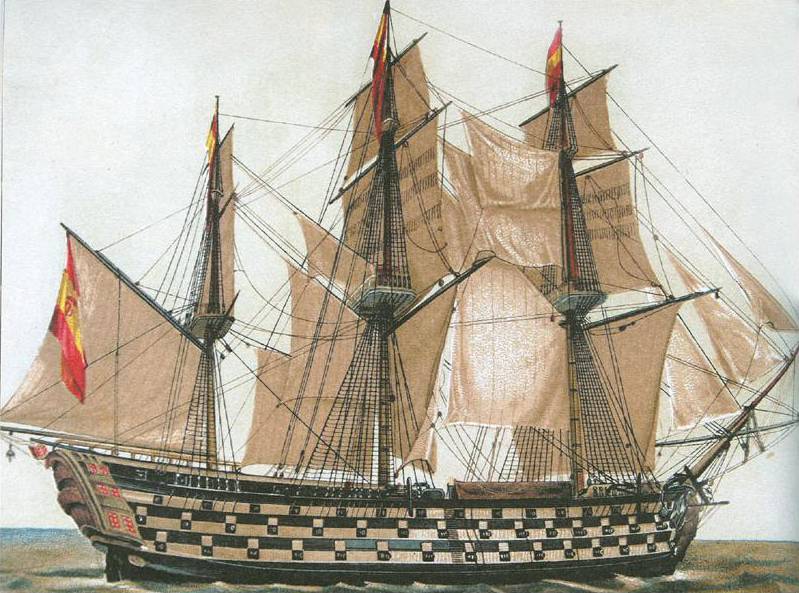
At the beginning of the XVIII century Spanish shipbuilding consisted of a large number of small Royal shipyards, scattered around the coast. The exact list of them, alas, is not known to me, because I did not dig so deeply, but from what I found, we can distinguish the shipyards Reales Astilleros de Falgote, Real Astillero de Santoña, Real Astillero de Guarnizo, Reales Astilleros de Esteiro, Real Carenero and the totality shipyards in the territory of the present city of Bilbao. Once upon a time, in a galaxy far far away, even under the Habsburgs in Spain, ships were built centrally, with fairly high standardization and unification, which should have been cheaper and simpler to build, but those times are long gone. Contracts were transferred to private firms, work in the shipyards was done carelessly, slowly and poorly, while the cost of construction remained quite high. The initial reorganization of the existing shipbuilding under Philip V did not help either - small enterprises could not jump higher than their heads. Powerful shipbuilding centers were required, combining all the necessary infrastructure not only for building ships, but also for timber harvesting, ship repair, upgrades, fleet maintenance, etc. - in simple terms, it was required to build full shipbuilding arsenals.
The first such complex in Spain was the grandiose Cartagena Arsenal, whose construction took as many 50 years - from 1732 to 1782 years. Prisoners' labor was actively used in its construction, and slaves were even brought from America - although slavery was long forbidden in the metropolitan area (from the time of Isabella the Catholic). Despite the fact that general work was completed only after 50 years after construction began, the first major ship here was laid in the 1751 year (the “Septentrion”). The second arsenal, the famous La Carraca near Cadiz, began to be built in 1752 on the basis of stunted local enterprises, and very quickly became a large industrial complex - the first ship of the line was laid at the same time as the construction began. Finally, Ferrolsky, which was also built on the basis of local small shipbuilding enterprises, became the third arsenal. The first major ship here was laid in the 1751 year. In all three arsenals, the organization of production met high standards, the construction of ships proceeded fairly quickly, cheaply and, above all, qualitatively. Before that, Spain had to build ships in the colonies, or even order them abroad - from the middle of the 18th century, the Spanish fleet had completely switched to the self-maintenance of the metropolis. By the end of the reign of King Carlos III, the power of Spanish shipbuilding became such that the arsenals of Ferrol or Cartagena could build a frigate six weeks from the time the order was issued - a great result for that time!
The armament of the Spanish fleet was supplied by the famous La Cavada, which I have already mentioned in the previous article. The main armament of the Spanish ships to the beginning of the Napoleonic Wars were guns and carronades caliber 36, 24, 12 and 8 pounds, as well as howitzers caliber from 24 to 48 pounds. The popularity of the carronades in the Spanish fleet was rather small - as far as I know, they were put on ships in fairly limited quantities, although there is unreliable information that the Santa Anu before the Battle of Trafalgar was completely rearmed into these short-barreled guns. In general, the ship's artillery in Spain was quite good, but in one it was seriously inferior to the English - if the Spaniards continued to use wick locks, then the inhabitants of Albion had already completely switched to flint shock, which were more reliable and simple. However, with the same wick gun locks, the French ships of the time also went into battle. Another disadvantage is the low saturation of the Spanish ships with carronades, which is why the overall rate of fire, which is already low, fell even lower.
Little about the effectiveness of artillery
About the arming of ships and its effectiveness at that time it is worth telling separately, although all further reasoning will be more of a divan analytics than a truth in the first instance. The fact is that with regard to the effectiveness of naval artillery of the Napoleonic wars there are two diametrically opposite points of view: that heavy guns were firing through ships, and that they did not break through thick wooden plating at all. According to my impression, after studying statistics and some sources, an impression can be concluded that both sides are wrong, and at the same time both are right in some way.
The fact is that according to Spanish sources, the 36-pound gun when firing a full charge of gunpowder, in ideal conditions and for some average statistical purpose (wooden board made of ordinary wood, in a single layer, with an average spacing of the frames) penetrated 65cm side plating from a distance of a kilometer and 130cm from the pistol shot distance. Meanwhile, such ideal conditions in the battle between battleships were most often absent - high quality material up to mahogany, lining in several layers, its constructive reinforcement with additional inner linings or even the simplest angles of the projectile as a result of maneuvering could reduce penetration of 36-pounders in two, three or more times. But the plating of the battleships of that time could have been very, very thick! So, at Santisima Trinidad, only the thickness of the outer skin of very strong mahogany wood reached 60, which, together with the inner skin, which was separated from the outside at some distance, gave the effect of exploded protection. As a result - for the "Santisime" in the Battle of Trafalgar, SEVEN British battleships were practicing for several hours, but the ship did not sink, but was taken to the boarding. From the received holes in the waterline area, the battleship took on water, but only the storm that began began finally sentencing him to death, otherwise the British would be able to tow it to Gibraltar.
Of course, this is an extreme case, and the survivability of wooden battleships at that era was somewhat lower, but if you look at the general statistics of losses in more or less large sea battles of that time between battleships and compare the numbers of sweats and captures, it turns out that for each dead in the classic battle, the ship accounted for 10-12 captured after the destruction of the upper decks, where the skin was usually somewhat weaker, and the demolition of all masts, which deprived the ship of the ability to move. In such cases, usually the crew of the captured ship previously suffered noticeable losses due to flying in all directions on the upper decks of wooden chips, which acted no worse than fragments. It is much more useful. weapons for such purposes, various carronades became available - they were enough to penetrate the sides on the upper decks, and the high rate of fire allowed us to literally throw an enemy with nuclei or a canister. The active rate of the British Navy on the carronades during the Napoleonic wars was probably another reason for their victory at Trafalgar.
Personnel
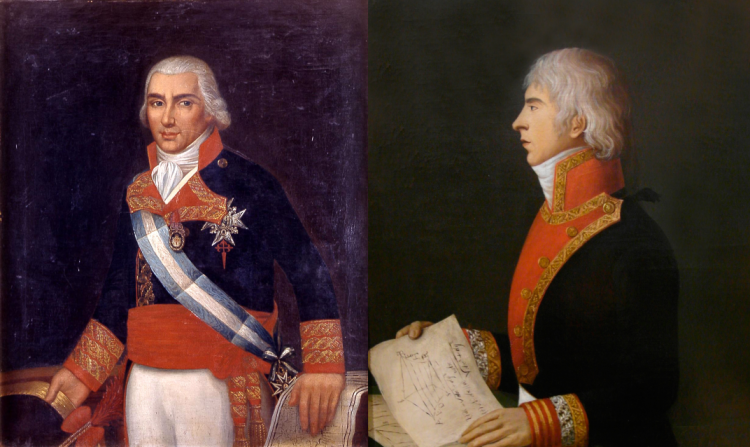
Naval traditions in Spain were among the oldest in Europe, and the training of sailors, in particular naval officers, was put on stream from ancient times. For example, in Spain for a long time there were naval academies where officers were trained, the largest of which was Academia de Guardias Marinas, located from 1769, in San Fernando, near Cadiz. All Spanish naval officers had a regular maritime practice, as had those sailors who had been on permanent naval service for many years. In this regard, the personnel of the Royal Armada was not inferior to the leading naval powers of the world, although it is traditionally considered that its quality was at best below average. Especially these high standards concerned officers who, in addition to professional selection, also underwent a “natural selection” when promoted - people who did not know how to earn the respect of a team simply did not admit to high positions. However, there were certain drawbacks - in some cases, inexperienced people could simply be in command of the position; in some way they received a position: there were no restrictions on increasing the length of service in the Royal Armada.
Speaking about the quality of the commanding staff of the Royal Armada of Spain, it is impossible not to recall her two outstanding officers - Federico Gravina and Cosme de Churruck. In general, both of these people are worthy of a separate article, because the scale of their personality, military abilities and popularity among sailors significantly exceeded all that is usually attributed to the Spanish admirals of the time. So, Gravin very highly appreciated Napoleon, considering him to be the best commander than Villeneuve, and expressly pointing out that if he commanded the allied squadron under Finisterre, they would have won the victory. He was an experienced officer who had gone through more than one war and had an important talent for the commander - organizational: he managed to organize large squadrons and transform them at the very least, but an interacting set of ships, which was even noted by King Carlos IV. Churruka was a bird of a slightly different flight, of something even higher - his scientific activity in America before the Napoleonic Wars was so successful and popular that the French and the British recognized his highest qualities. But what can I say - in his time Napoleon spoke with him personally, who responded well to the Spaniard after that! But it was not only this that Churruk was strong - like Gravin, he was distinguished by outstanding organizational skills. After the end of his career as a researcher, he entered the navy, and his ships quickly turned from rashlyannyh to exemplary. Based on his own experience with the teams, Churruk made plans for modernizing the Armada - to improve the skills of personnel, to create an adequate system of combat training, to create a unified system of armament of battleships, to improve ship discipline, which the Spaniards traditionally limped ....
The battle of Trafalgar was the decline of the Spanish Armada, and the fate of its two best officers was very tragic. Both Gravina and Churruka opposed the withdrawal of the allied squadron from Cadiz, but Villeneuve insisted on his own, and the Spaniards had to come to terms with his decision. During the battle, Gravina was on the 112-gun "Principe de Asturias", was seriously wounded, but brought his ship and some others from the battle, when it became clear that he had been lost. Gravina did not calm down on this, and having quickly repaired his ships, he sent them after the British to beat off the captured Spanish battleships. Alas, the impulse turned out to be almost fruitless - only one Santa Ana managed to be repulsed, the beginning storm prevented further actions. Cosme de Churruk commanded the "San Juan Nepomuseno", who had a chance to grapple with six British ships. Churruk’s actions in the battle were brave, and his team probably acted better than the rest of all the Spanish ships thanks to the talent of his commander, who trained the necessary qualities of his crew. But in the midst of the battle, the brave basque (Churruk was from Basque) was blown off by a leg, and he soon died from blood loss. The surviving members of the ship instantly lost heart, and soon surrendered when the ship was already badly beaten and lost the opportunity to continue resistance. It was not only the allies who mourned him, but also the enemies - it was a man of such magnitude. But shortly before the Battle of Trafalgar, Churruk married for the first time .... Federico Gravina briefly survived him, having died from the effects of the wound received at Trafalgar. The names of these two naval officers are revered in Spain so far.
Beginning for health, we finish for the rest
Unfortunately, all the above mentioned good sides of the Armada overlapped with weighty flaws. The biggest problem was the general low quality of training sailors - in wartime, the vast majority of them on ships turned out to be inexperienced recruits or random people in general. The reasons for this situation are closely intertwined with other reasons for the decline of Armada, as a result of which four large points can be distinguished, which the Spanish fleet was sentenced.
Cost savings. The fact is that under the Bourbons in the XVIII century, there was a redistribution of expenditures of the treasury - if at the Habsburgs huge sums were spent on the maintenance of armies or third-party expenses, then under the Bourbons finance began to be invested in domestic development. However, to get out of a long decline, and even begin to develop, it required an extremely large amount of money - and it was decided to save on the armed forces. If in the land forces of that time the states of peace and wartime differed little (in Russia the difference was about 200 people per regiment, or around 10%), then in Spain the staff of the peacetime and wartime regiment differed 2,2 times! Replenishment of the regiment was due to the recruitment of recruits and veterans, previously dismissed from the service - but the adequate deployment and training of these people took considerable time. A similar situation developed in the fleet - peacetime states were very different from the military states, with the result that in the event of war professional sailors "dissolved" against the background of a large number of recruits that were required for the full functioning of warships. This system still somehow functioned under Carlos III, but every year under Carlos IV and Manuel Godoy, the savings were only exacerbated - the Spanish treasury could not withstand both military spending and the huge subsidies that it pledged to France. For example, before the Battle of Trafalgar, many officers had not been paid their salaries for many months, although they had received money regularly before. Not only that - there is evidence that some captains had to pay out of their own wallet to put ships in order before the battle (meaning painting), since for the same reason many first-class battleships were already rotting at the walls, left without crews! The talentless leaders and the alliance with France ruined the economy of Spain, and this could not but affect its fleet.
Low quality recruits. Judging by the information that I have seen on the Internet, the quality of recruits who fell into the Armada was quite low. Some blame geography for this - they say, most of the recruits were recruited in the countryside and were illiterate, but the same alignment with the recruits did not prevent the Russian Imperial fleet from having well-trained personnel. Most likely, the reason was different - in the event of war, the best people were taken to the army, a significant number of volunteers went there (including — not to get into the fleet, because the army even paid regularly), and the fleet had to deal with the remnants , and these were most often various tramps, criminals and other low-quality human material. It cannot be said that, for example, the situation was better in the UK navy - there was also rowing everyone there, but Great Britain did not have such a large army that competed with the fleet for human resources, in peacetime the crews did not shrink to the very minimum, and they still did better combat training of personnel there - which brings us to the next point.
Insufficient level of combat training. If the British Navy used its crews to complete (with rare exceptions), then combat training in the Spanish Navy seemed to be reduced to a minimum in wartime. But what is there - even in peacetime, the Spanish professional sailors could really be masters of their craft in maritime navigation, but practically had no experience in handling ship artillery. This was aggravated even more by diluting this professional unit with recruits in the event of war, which led to a truly catastrophic result - in the Battle of Trafalgar for every shot of the Spanish 36-pound cannon the British could respond with two or three guns of the same caliber [4]. The Spanish naval officers also understood this, but due to the inertia of the headquarters’s thinking and the economy in the navy, the plan of combat shooting aimed at improving the quality of training of cannon servants, proposed by Churruka, was adopted only in 1803 year, but it wasn’t carried out before the Trafalgar battle! There were also problems of rafting - in peacetime, the main service of the ships took place in proud solitude, rarely in small units. When for the big war it was necessary to act as part of numerous squadrons, almost any command maneuver turned into an insurmountable task, and the Spanish ships as a result "went in some kind of herd." Churruk also pointed to this shortcoming, but who was listening to him in 1803-1805 for years ...
"Mess on the ship". In the process of studying the organization of the army and navy of Spain in the XVIII - early XIX century, you very quickly start to get confused and surprised, because where in Russia, Prussia or France there was a clear structure, in Spain there was real chaos, albeit organized as much as possible. It was expressed in different ways, and could be closely connected with the peculiarities of the Spanish mentality - so, the Spanish soldiers and sailors were always sensitive to the quality of the commanders: if the commander did not enjoy their respect, the discipline fell below the baseboard, as did the fighting ability. But with proper motivation and the commander from the category of “servant to the king, father to the soldiers”, the same Spanish soldiers and sailors could work wonders of courage and resilience. Discipline in general was a problem place for the Spaniards - here, perhaps, the features of the Spaniards mentality also affected. The salary situation did not at all contribute to raising this discipline - sailors on ships were paid less than soldiers in the regiments, which also caused the problem of desertion from the fleet of people, including experienced professionals. Bardak also dealt with organizational issues - thus, there was a practice in the event of a shortage of artillery maids on a ship to remove artillerymen from coastal batteries, or even to “borrow” them from the army in the field. Needless to say, being on an unfamiliar ship and unfamiliar cannons, these people could not be compared with the English professionals, even if these Spanish gunners were masters of their craft on land?
Of course, these are only the most general estimates, but in sum, they would give exactly the effect that was obtained in reality - first of all, bad wartime cadres wouldn’t allow realizing the good sides of the Royal Armada, and other reasons, to which one can also add embellishment in The rear structures, especially developed under Carlos IV, only aggravated the situation. As a result of all this, Spain, despite all the efforts under Carlos III, still lost its sea power. After the Battle of Trafalgar, the fleet in Spain was completely forgotten, and during the years of the Pyrenean War, it was simply not up to him - and 20 years after the famous battle in which Nelson, Gravina and Churruk died, the Armada almost disappeared from the seas and oceans.
Notes
1) I found references to at least five royal shipyards on the shores of Biscay, Asturias and Galicia; thus, the theses expressed by some about the absence of shipbuilding in Spain itself are unfounded.
2) Some sources call the digit 9, but most likely it is erroneous.
3) For comparison: in the UK, the force of large shipyards during the same time built the 261 battleship.
4) However, the secret of the British high rate of fire also lies in the accumulation of gunpowder and nuclei for the first shots at the beginning of the battle - this increased the ship’s risk of taking off into the air or at least incur serious losses from the explosion of the “first shots” stock, but on the other hand it significantly reduced reloading time for guns due to the absence of the need to carry ammunition from the cellars.
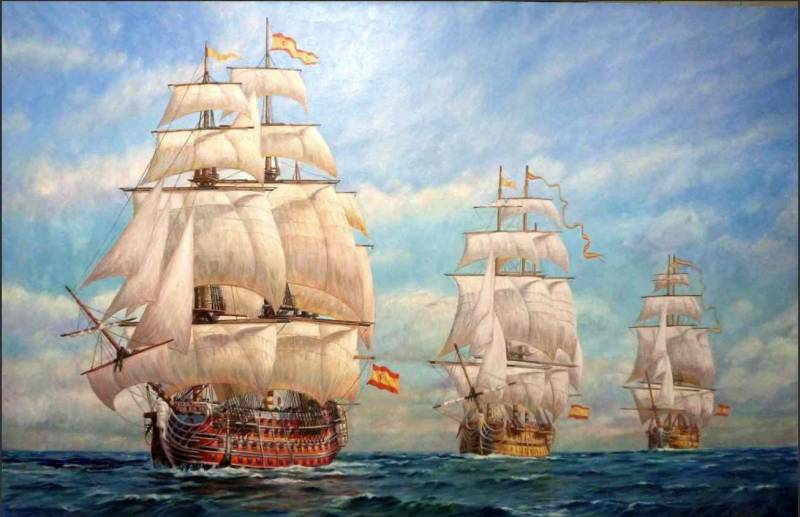
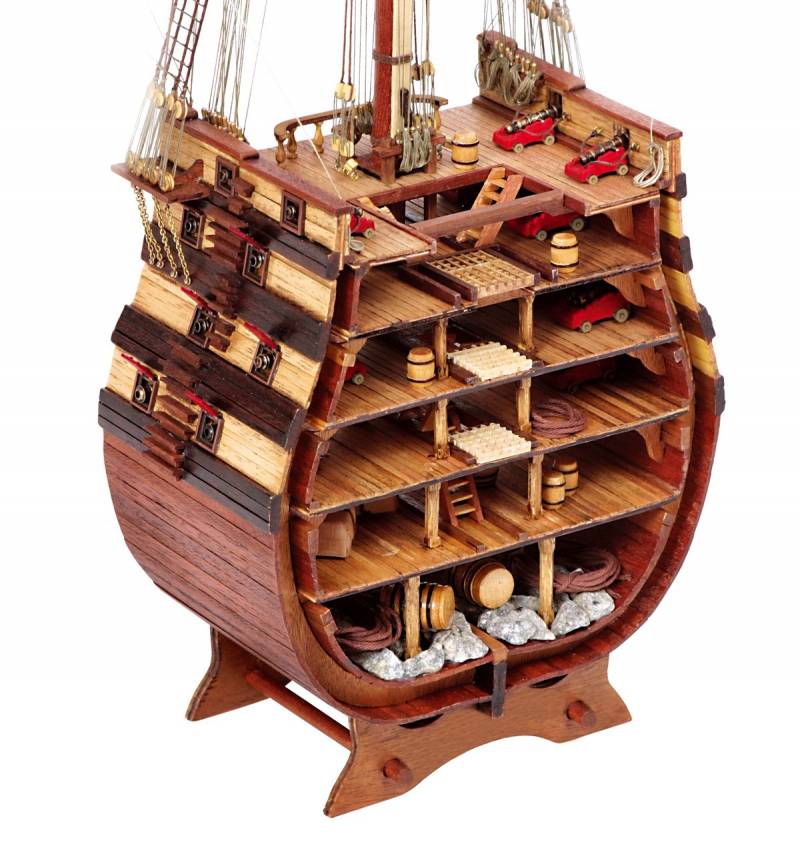
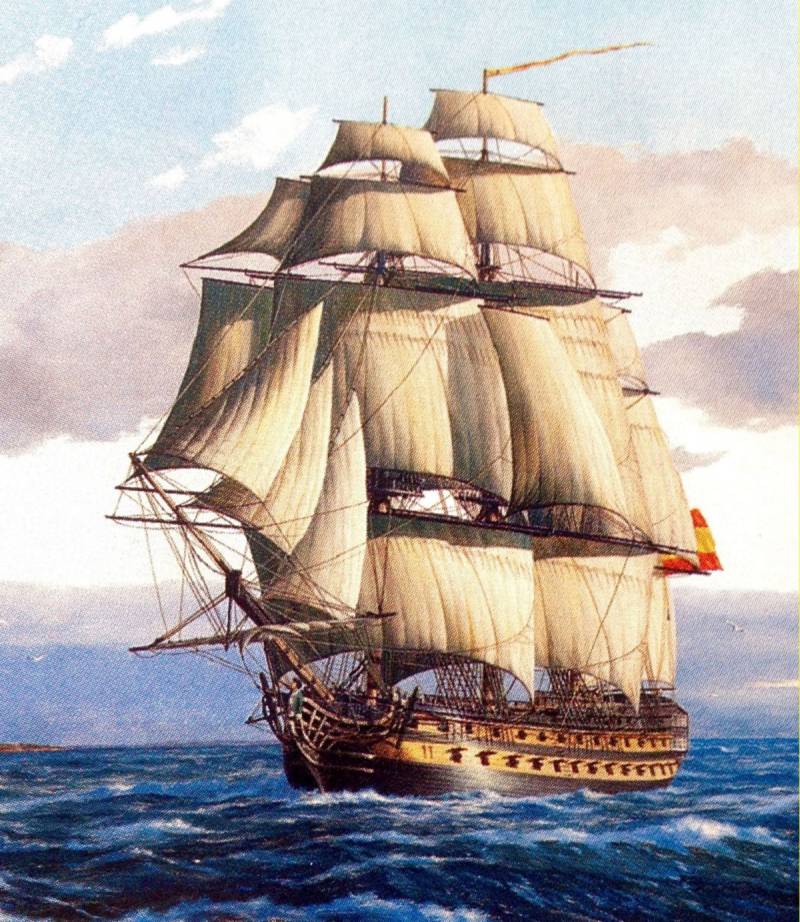
Information